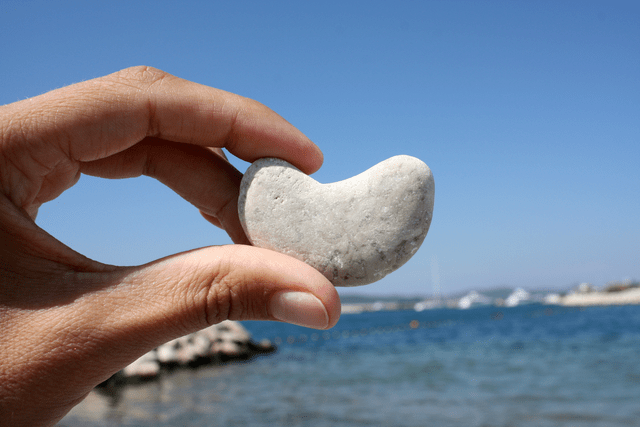Spend some time outdoors and you’re bound to get a rock in your shoe. Every single step sends pain through the sole of your foot. You can’t walk again until you shake that little thing out of your shoe, often to find that it’s much smaller than the pain would make you think.
Now, imagine one of those pebbles being lodged in your kidneys or slowly moving through your urinary tract. There’s no way to shake it loose like a rock in your shoe. But there are a number of ways to get rid of it to get relief.
 1. Pass the kidney stone.
1. Pass the kidney stone.
Once you have kidney stone pain, it’s actually already passing. It may have been stuck inside your kidney for years before finally working it’s way down to the ureter (the tube connecting the kidney to the bladder), where it causes an obstruction and that terrible pain. From there, the stone might be able to pass the rest of the way on its own.
“Your probability of passing a kidney stone is based on its size. Small stones usually pass. Bigger stones usually don’t. But it’s not completely predictable,” says Steven Rosenberg, MD, a urologist at The Iowa Clinic.
A kidney stone of 4 millimeters (about the width of two stacked nickels) or smaller is highly likely to pass. But it can take up to a month. Stones of 6 millimeters or more are not likely to make it. For stones in that 4 to 6 millimeter gray area, just over half do pass naturally in about 45 days.
But even tiny kidney stones can cause considerable pain. So it’s less a question of size and more a matter of how you feel during this time. If taking an over-the-counter pain medication like acetaminophen or ibuprofen isn’t enough to ease your discomfort, you need to consider your other options.
2. Pulverize the kidney stone into tiny, passable pieces.
Lithotripsy is a procedure that breaks down kidney stones into fragments that are small enough to pass or easy to remove in a kidney stone surgery. One form of the procedure, extracorporeal shock wave lithotripsy (ESWL) is commonly used for stones in the kidneys and upper ureter.
“It’s completely noninvasive. We use an X-ray to localize the stone and a machine that generates shock waves focused on the stone,” explains Dr. Rosenberg. “It pulverizes the stone into little pieces that can then pass. It’s useful for small or medium-sized stones that are up in the kidney.”
ESWL has about a 90 percent success rate in breaking up kidney stones in just one treatment, he says. No invasive surgery is involved — it’s all external — so there are no restrictions or recovery afterward. Most people don’t experience significant pain passing the fragmented kidney stones, either.
 3. Break up the kidney stone and pull out the pieces.
3. Break up the kidney stone and pull out the pieces.
There’s another form of lithotripsy that uses a laser at the end of a scope that is passed up the urethra, through the bladder and into the ureter. Once the stone is located, it’s broken to bits with the laser, and the pieces are extracted.
“We can sometimes pull stones out with just a ureteroscope. But because of the size, position or shape, sometimes pulling them out isn’t possible,” says Dr. Rosenberg. “We do an ureteroscopy with lithotripsy to break the stone up into smaller pieces and then pull those out. And we usually place a stent to help the kidney drain while the swelling goes down.”
Ureteroscopy is typically used when a stone has already passed out of the kidney, down into the ureter. It’s a minimally invasive kidney stone removal procedure. There are no incisions, so it takes less than a week to recuperate.
“The nice thing about ureteroscopy is that the stone is removed. You don’t have to wait for it to pass,” Dr. Rosenberg says. “All you have to do is recover from the procedure, and that’s usually pretty quick.”
 4. Undergo kidney stone removal surgery.
4. Undergo kidney stone removal surgery.
More invasive surgery is the least likely scenario, reserved for large kidney stones that can’t be removed through other means.
“There’s a less common procedure called percutaneous nephrolithotripsy. We pass a needle into the kidney through the back. We enlarge the needle tract and then put a scope down into the kidney and break up big stones with lasers and other means. Then, we pull them out through a tiny incision in the back,” Dr. Rosenberg explains.
Percutaneous nephrolithotripsy is primarily used for kidney stones that are 2 centimeters or larger — or about the same size as a marble. These stones are way too big to pass and are stuck up in the kidney.
Percutaneous nephrolithotripsy may also be necessary for an oddly-shaped kidney stone that is unable to pass. It’s the most invasive of the kidney removal procedures, and it can take several weeks to recover.
 5. Prevent kidney stones before they form.
5. Prevent kidney stones before they form.
The best — and least painful — way to get rid of kidney stones is to stop them before they start. Because once you’ve had one kidney stone, you’re more likely to get another. Some people are just predisposed to getting them.
“People who form stones, there’s a reason for it. And it’s usually something metabolic. Their body is putting out too much calcium or they don’t have enough citrate,” says Dr. Rosenberg.
The kidneys’ job is to process waste. And when your body sends too much of a mineral (like calcium or sodium) to the kidneys to flush out in the urine, it can collect and crystallize into a stone. While there are medications that help pull out some of the excess minerals or dilute concentrated urine, there are several simpler strategies to prevent kidney stones from forming:
- Drink (more than) enough water. You want to get enough fluids that you’re able to fill a one-liter bottle more than two times with urine each day, Dr. Rosenberg says. That’s not as simple as drinking two liters of water, which is just more than the often recommended eight glasses. You have to drink enough to consistently produce that output in your urine and not lose it through sweat or by other means.
- Splash in some lemon juice. “Citrate interferes with calcium stone crystallization and the best dietary form of citrate is lemon,” Dr. Rosenberg says. Drop a slice of lemon in your water, drink real lemonade and squirt lemon juice on your meals to get plenty of citrate.
- Hold the salt. Excessive sodium in your diet is another source of kidney stones. So you need to restrict sodium and be cautious eating at restaurants where meals are filled with salt. “The more you can eat fresh fruits and vegetables, cook your own food and manage the sodium intake, the better,” Dr. Rosenberg says.
- Moderate high-oxalate foods. Oxalate, or oxalic acid, is an antinutrient that’s bound to minerals in many plants that can also cause kidney stones. Dr. Rosenberg advises patients to limit food sources high in oxalates like spinach, rhubarb, beets, sweet potatoes, peanuts and almonds. Since the foods are very healthy, you don’t want to avoid them entirely.
- Eat less meat. Up to 85% of kidney stones are made of calcium. The other 15% are most often made of uric acid, which is commonly found in animal protein. Limit your intake of meat, including eggs and seafood, to a quantity no bigger than a deck of cards.
Most kidney stones are not dissolvable, Dr. Rosenberg says. So these dietary tips are unlikely to get rid of a stone after it forms. They do, however, reduce the amount of minerals in your kidneys and keep them from growing.
“We try to manage your diet and hydration first. It’s the best thing you can do to lower your risk of kidney stones,” he says. “It’s like a big chemistry lab in your urine. The idea is to keep the concentration low enough that the minerals float around instead of crystalizing and forming stones.”
If you’ve passed a kidney stone before, there very well could be others up there waiting like ticking timebombs of pain. You need to be diligent with your diet and keep an eye out for the early signs of kidney stones.


